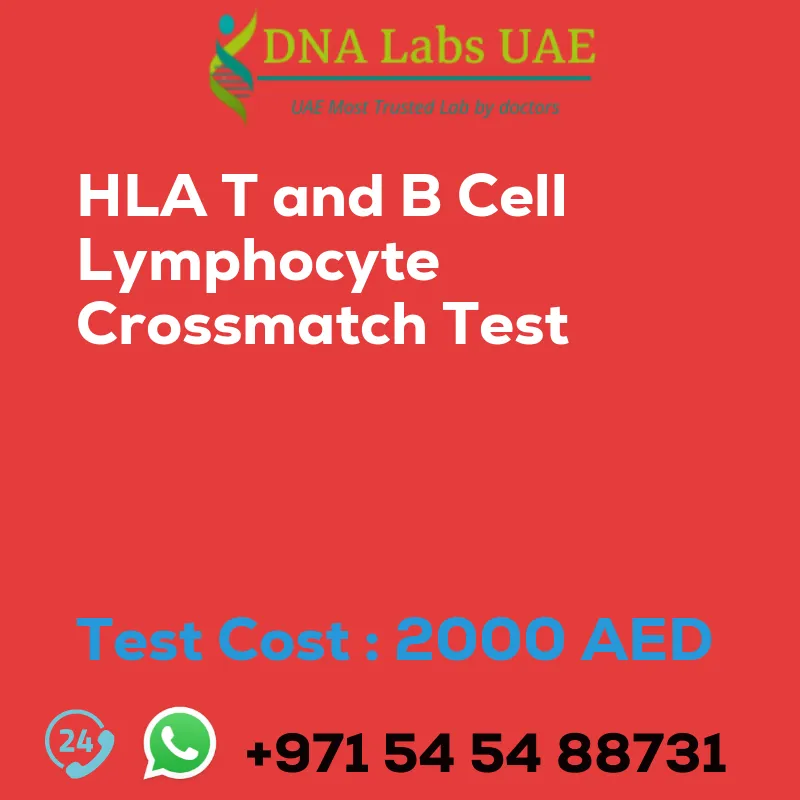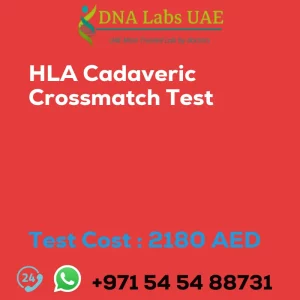HLA T and B CELL LYMPHOCYTE CROSSMATCH Test
Test Name: HLA T and B CELL LYMPHOCYTE CROSSMATCH Test
Components: HLA T and B CELL LYMPHOCYTE CROSSMATCH Test
Price: 2000.0 AED
Sample Condition:
- RECIPIENT: 6 mL (3 mL min.) whole blood in 1 Yellow Top (ACD) tube AND 3 mL (2 mL min.) serum from 1 SST. Collect specimen preferably 48 hours after dialysis.
- DONOR: 12 mL (10 mL min.) whole blood in 2 Yellow Top (ACD) tubes. Ship refrigerated. DO NOT FREEZE. Brief history in Solid Organ Transplant Consent form (Form 33) is mandatory.
- Doctor’s prescription on the letterhead with stamp AND 1 photograph each of recipient and donor is mandatory.
Report Delivery: 10-12 days
Method: Complement Dependent Cytotoxicity with DTT treatment
Test Type: Transplantation
Doctor: Nephrologist
Test Department:
Pre Test Information: Collect specimen preferably 48 hours after dialysis. Doctor’s prescription on the letterhead with stamp AND 1 photograph each of recipient and donor is mandatory. Brief history in Solid Organ Transplant Consent form (Form 33) is mandatory.
Test Details:
The HLA T & B cell lymphocyte crossmatch test is a laboratory test used in organ transplantation to determine the compatibility between the donor and recipient. HLA (Human Leukocyte Antigen) molecules are proteins found on the surface of cells that play a crucial role in the immune system. The immune system uses these proteins to identify self from non-self cells. In organ transplantation, the compatibility of HLA molecules between the donor and recipient is important to minimize the risk of rejection.
The T & B cell lymphocyte crossmatch test specifically assesses the compatibility of T and B lymphocytes between the donor and recipient. T lymphocytes are responsible for cell-mediated immunity, while B lymphocytes are involved in humoral immunity. By testing the compatibility of these lymphocytes, the crossmatch test provides additional information about the potential risk of rejection.
During the test, lymphocytes from the donor and recipient are mixed together in a laboratory setting. If the recipient’s immune system recognizes the donor’s lymphocytes as foreign, it will initiate an immune response, leading to the activation of various immune cells and the release of inflammatory mediators. This immune response indicates a positive crossmatch and suggests a high risk of rejection.
On the other hand, a negative crossmatch indicates that the recipient’s immune system does not recognize the donor’s lymphocytes as foreign. This suggests a lower risk of rejection and indicates better compatibility between the donor and recipient.
The HLA T & B cell lymphocyte crossmatch test is an important tool in assessing the compatibility of organ transplant recipients and donors. It helps transplant teams make informed decisions about the suitability of a donor and choose the best match to minimize the risk of rejection and improve the success of the transplant.
| Test Name | HLA T and B CELL LYMPHOCYTE CROSSMATCH Test |
|---|---|
| Components | |
| Price | 2000.0 AED |
| Sample Condition | RECIPIENT: 6 mL (3 mL min.) whole blood in 1 Yellow Top (ACD) tube AND 3 mL (2 mL min.) serum from 1 SST. Collect specimen preferably 48 hours after dialysis.\nDONOR: 12 mL (10 mL min.) whole blood in 2 Yellow Top (ACD) tubes. Ship refrigerated. DO NOT FREEZE. Brief history in Solid Organ Transplant Consent form (Form 33) is mandatory. \nDoctor’s prescription on the letter head with stamp AND 1 photograph each of recipient and donor is mandatory. Above specimen requirements are for a single donor being cross matched with a single receipient. Separate registrations required for 1 Donor & 1 Recipient. For additional cross matches, send additional specimens of donors. Request as additional tests. For Post Transplant suspected cases of Acute rejection, photographs are not mandatory. |
| Report Delivery | 10-12 days |
| Method | Complement Dependent Cytotoxicity with DTT treatment |
| Test type | Transplantation |
| Doctor | Nephrologist |
| Test Department: | |
| Pre Test Information | Collect specimen preferably 48 hours after dialysis. Doctor’s prescription on the letter head with stamp AND 1 photograph each of recipient and donor is mandatory. Brief history in Solid Organ Transplant Consent form (Form 33) is mandatory. |
| Test Details |
The HLA T & B cell lymphocyte crossmatch test is a laboratory test used in organ transplantation to determine the compatibility between the donor and recipient. HLA (Human Leukocyte Antigen) molecules are proteins found on the surface of cells that play a crucial role in the immune system. The immune system uses these proteins to identify self from non-self cells. In organ transplantation, the compatibility of HLA molecules between the donor and recipient is important to minimize the risk of rejection. The T & B cell lymphocyte crossmatch test specifically assesses the compatibility of T and B lymphocytes between the donor and recipient. T lymphocytes are responsible for cell-mediated immunity, while B lymphocytes are involved in humoral immunity. By testing the compatibility of these lymphocytes, the crossmatch test provides additional information about the potential risk of rejection. During the test, lymphocytes from the donor and recipient are mixed together in a laboratory setting. If the recipient’s immune system recognizes the donor’s lymphocytes as foreign, it will initiate an immune response, leading to the activation of various immune cells and the release of inflammatory mediators. This immune response indicates a positive crossmatch and suggests a high risk of rejection. On the other hand, a negative crossmatch indicates that the recipient’s immune system does not recognize the donor’s lymphocytes as foreign. This suggests a lower risk of rejection and indicates better compatibility between the donor and recipient. The HLA T & B cell lymphocyte crossmatch test is an important tool in assessing the compatibility of organ transplant recipients and donors. It helps transplant teams make informed decisions about the suitability of a donor and choose the best match to minimize the risk of rejection and improve the success of the transplant. |








